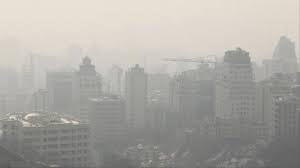| নির্বাচিত পোস্ট | লগইন | রেজিস্ট্রেশন করুন | রিফ্রেস |
 সত্যের সারথি সাদেক
সত্যের সারথি সাদেক
সত্য যে বড় কঠিন, কঠিনেরে বাসিলাম ভালো, যে কখনো করেনা বঞ্চনা !
* Zahidul Islam
**Professor Dr. Mallik Akram Hossain
Air pollution is simply meaning that- ‘The excessive presence in the air of one or more substances that have harmful or toxic effects on the constituents of the environment.’ According to the World Health Organization (WHO), ‘Air pollution is the contamination of the indoor or outdoor environment by any chemical, physical or biological agent which alters the natural characteristics of the atmosphere and disturbs the natural state of the environment.’
The atmosphere contains a certain percentage of gases. An increase or decrease in the composition of these gases is detrimental to the survival of organisms. Prevention of air pollution is so important that the Sustainable Development Goals (SDGs) are prominently mentioned in goals 3 and 11 of air quality management. Optimum results can be achieved by ensuring clean air through an integrated approach to air quality management. If we failed, the dream of achieving Sustainable Development Goals will remain unfulfilled.
Causes of air pollution
According to a study by the Bangladesh Atomic Research Council (BARC), 58% of air pollution in Dhaka is caused by about 4,500 brick kilns on the outskirts of Dhaka. In addition, 15.3% of dust, 10.4% of vehicles smoke, 7.6% of lead, 7.4% of fossil fuels (coal, oil, and natural gas), and 1.3% of sea salt are responsible. Apart from this, industries, unplanned urbanization, frequent digging of roads, dumping of drains on the side of the road, various types of particulate matter, carbon, carbon monoxide, sulfur oxides, nitrogen oxides, and carbon dioxide emitted from incomplete fuel of vehicles are constantly polluting the air.
Recently, a study conducted by the experts of the Department of Environment of Bangladesh has shown that baby taxis, tempos, mini-trucks, motorcycles, and other vehicles with two-stroke engines in the capital are the main sources of air pollution in Dhaka city.
According to BRTA data, there are at least 5 lacs 40 thousand and 77 unfit vehicles in the country till November last year. It is also known that 59 thousand and 48 cars without fitness have increased in about a year. Every day these defective and unfit vehicles emit black smoke on the roads of Dhaka metropolis. Vehicles using petrol and diesel produce black smoke and carbon monoxide. Studies have shown that tanneries on the outskirts of Dhaka emit Ammonia gas, Chlorine and Hydrogen Sulphide gases, and some other highly toxic chemicals which are playing the role of a silent killer to the townspeople. In particular, industrial areas and commercial areas are more polluted than residential areas. However, some residential areas are as polluted as industrial areas. These include Mohammadpur, Farmgate, Manik Mia Avenue, Tejgaon, Mohakhali, Gabtali, Mirpur, Banoshri, etc. the most affected areas of Dhaka city. Generally, air quality is 400 mic. gm/m3 but air quality in these areas can sometimes be as high as 3,000 mics. gm/m3.
Recent air pollution trend in Bangladesh
The air pollution in Dhaka at 8 am on September 25 at three locations was 'moderate', but it is up warding to the worse side. The Air Quality Index (AQI) of three places is– Gulshan (American Embassy) 88, Niketan 50, and Old Dhaka 99 (near Azimpur). But in the meantime, the worrying fact is that the AQI value in Kapasia in Gazipur was 163. Being an industrial area, its value exceeds 300. As can be seen from the trend of AQI, it is going to highest from afternoon to midnight. Then it gradually decreases. Air pollution starts again at 9 am. According to English daily on August 3 of this year, Bangladesh is in the 4th position in terms of air pollution. Santiago of Chile, Lahore of Pakistan, and Riyadh of Saudi Arabia occupied the first three places. The news also said that Dhaka's air quality index (AQI) was recorded at 154 around 10 am that day.
According to the World Health Organization (WHO), an AQI between 101 and 200 is considered 'unhealthy', posing a health threat to vulnerable groups. Similarly, an AQI score between 201 and 300 is considered ‘poor’, while a score between 301 and 400 is considered ‘hazardous’ while readings of 301 to 400 are considered ‘dangerous’, posing serious health risks to residents.
Effects on human health
Air is constantly polluting our environment. The picture of pollution is so dire that every year millions of people are injured or killed due to pollution. According to the World Health Organization (WHO), about 98 percent of cities in low- and middle-income countries do not meet WHO air quality guidelines whereas in high-income countries this percentage remains constant at 56 percent. A survey of air quality in 3,000 cities in 103 countries worldwide found Bangladesh's major cities like Dhaka, Narayanganj, Gazipur, Chattogram, Barisal, Khulna, and Sylhet topping the list. In general, air quality in these cities has a high impact on public health.
Stroke, heart attack, lung cancer, bronchitis, kidney disease, high blood pressure, birth defects, effects on mental health, liver problems, effects on pregnancy, skin diseases and pneumonia, etc. are chronic diseases. According to the United Nations, 9 out of every 10 people worldwide breathe polluted air and nearly seven million (7 million) people die each year, especially in low- and middle-income countries. According to the World Bank's Country-Environmental Analysis (CEA) 2018 report, the number of deaths due to air pollution in Bangladesh is about 46 thousand which poses a serious health risk to residents.
Steps can be taken to prevent air pollution
Recently, a study about the environmental impact of Metro rail construction had been conducted by a thesis student of Jagannath University under Professor Dr. Mallik Akram Hossain. They have been suggested several recommendations to prevent air pollution in Dhaka city. Among these are - to control the dust with water on the road or to burn the garbage. Factories should be moved out of the city. 70-80% of pollution can be reduced by increasing the use of advanced fuels, reducing the use of air conditioners, and converting traditional brick kilns to energy-efficient and environment-friendly ones.
Air pollution can be reduced to a great extent by planting trees. Vehicle maintenance and fitness checks should be carried out regularly. Mainstream vehicles will have to convert into an electrical system. Discourage private vehicles and encourage public transport. Ban on the burning of household waste should be strictly enforced. Air pollution can be prevented through increased renewable energy generation, legislation and enforcement, and public awareness.
Role of youth in air pollution control
When talking about the role of youth in air pollution or the environment, the first thing to talk about is Greta Thunberg. Who caught the attention of the world with the slogan ‘Friday for Future’ at the age of sixteen and become a climate hero. This teenager has taken herself to the highest level in the environmental movement. By organizing the ‘Climate Protest’ march, she has risen to the leadership of the world's environmental movement. On September 20, 2019, she was seen marching in the streets of New York with hundreds of people. On his call, schoolchildren from 185 countries took to the streets. This incident is enough to highlight the role of youth in the environmental movement. Greta Thunberg's speech at Cop-26 was quite inspiring. She said there, ‘We don't need to set targets for 2030 or 2050 only. Above all, we need to set targets for 2020 and beyond every month and year.’
The sapling that is trampled underfoot today, in the future that sapling will become a beauty and give shade to the living; similarly, the person who is a student today, or will provide the potential future of society in the near future.
Authors
*Student and Journalist, Jagannath University, Dhaka.
** Former Chairman and Professor, Department of Geography and Environment, Jagannath University, Dhaka.
২| ![]() ৩০ শে অক্টোবর, ২০২২ সকাল ৯:৪৮
৩০ শে অক্টোবর, ২০২২ সকাল ৯:৪৮
সত্যের সারথি সাদেক বলেছেন: আমার লেখা ভাই।
৩| ![]() ৩০ শে অক্টোবর, ২০২২ সকাল ১০:১৭
৩০ শে অক্টোবর, ২০২২ সকাল ১০:১৭
মোহাম্মদ গোফরান বলেছেন: ইংলিশ হলেও চমৎকার একটি আর্টিকেল । ধন্যবাদ।
©somewhere in net ltd.
১| ৩০ শে অক্টোবর, ২০২২ রাত ৩:৫৭
৩০ শে অক্টোবর, ২০২২ রাত ৩:৫৭
সোনাগাজী বলেছেন:
আপনার লেখা, নাকি কপিপেষ্ট?